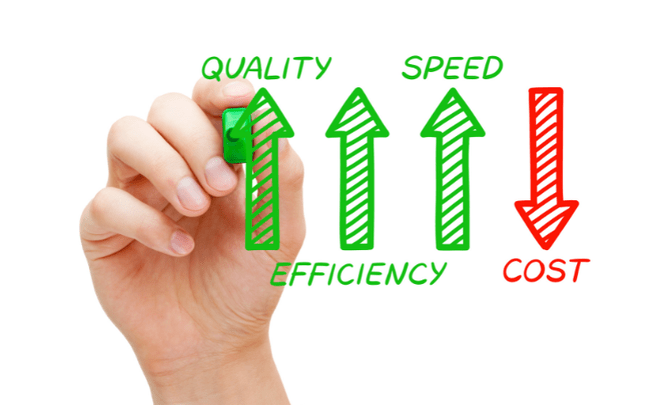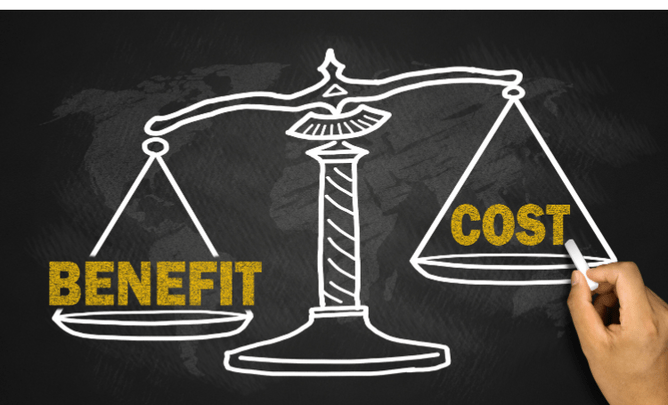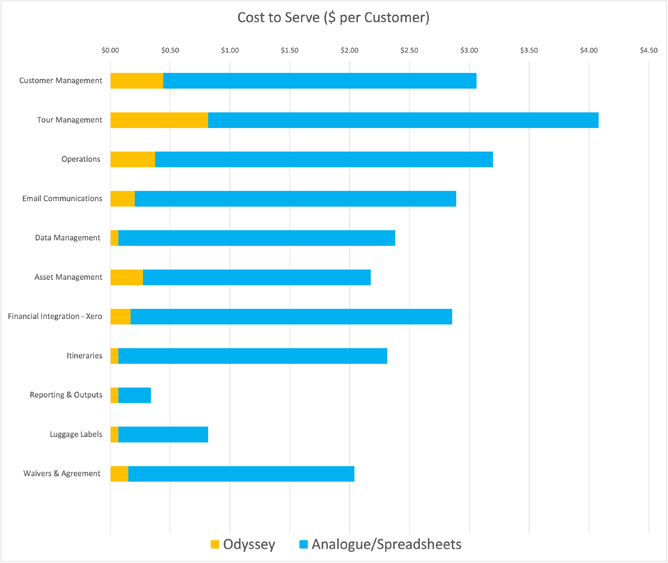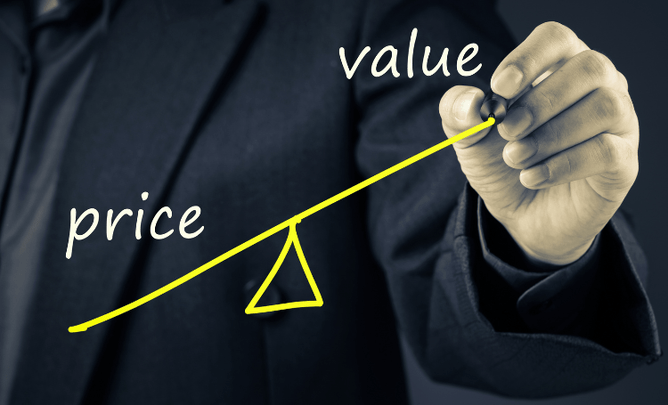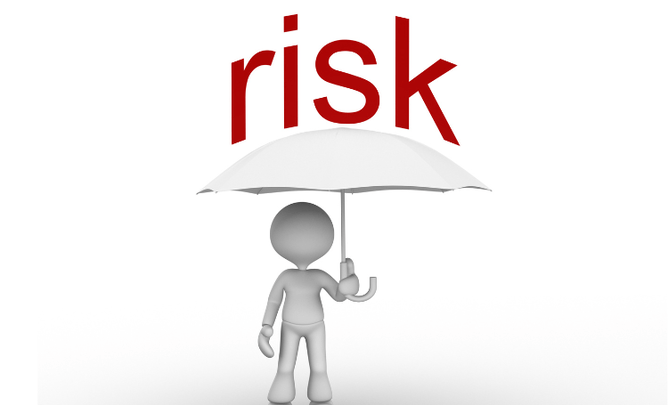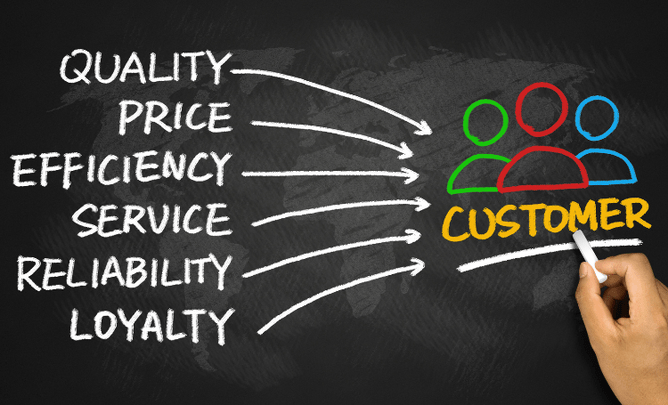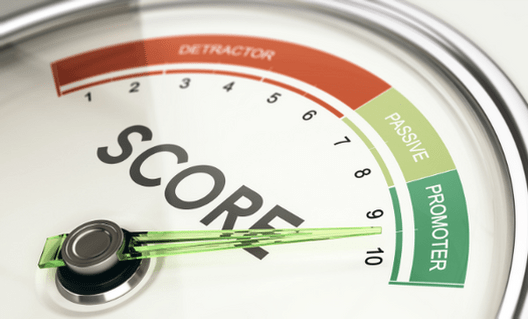NOTE: This is not an article about Res Tech (Reservation Booking Systems)... this blog considers the value of a 'Fit for Purpose' Operating System that acts as the hub for all your tourism business activity.
The value of ‘fit for purpose’ software
vs the cost of not having it...
If you want to deliver high quality customer experiences you need a modern software solution that seamlessly deliveries your admin, customer and supplier and operational services. In addition this tech ecosystem should leverage new technologies, save you money and integrate with other systems.
ROI (return on investment) calculations for software can be difficult to perform because there are often many variables that determine the values and costs of an individual business. So in this article we simply look at both sides of the equation eg the value of having fit for purpose software for your tourism business vs the cost of not having eg your status quo.
Understanding the WHY is the first step...
If you're currently using spreadsheets check out our blog post on moving into streamlined software.
WHY choose 'fit for purpose' management
software for your tourism business
We think there are 4 main areas where you will see value added benefits...
Increase Revenue - create new products, move into new locations or trails, and realise the return from repeat, referrals and reviews. One of the easiest way to grow you business is to be 'good' at what you do for your existing customers.
Decrease Costs - Reduce the cost to acquire and serve your customers and your margins will improve. Stop duplicating, copy n paste etc... it's a killer on your staffs time. And just run your operations much more efficiently by being organised. Happy staff will stay with you longer.
Decrease Risk - Overlooking customer charges, not confirming suppliers bookings on time, lost luggage, over allocating resources, H&S, quality of service delivery...all of these these risks can be reduced with a streamlined approach.
Increase the value of your business - A fit for purpose Operating System is an intangible asset to your business, spreadsheets or legacy systems can be a liability. Why would I want to acquire your business if you don't have good Operating Systems...one that I can grow the business with.
The cost of maintaining
the status quo...
Financially it might seem like a big leap from ‘FREE’ spreadsheets, or a $19.99 a month app, to a comprehensive software solution that appears to cost more... but does it really?
Let's take a look at how you can break things down to understand the true costs...
Step 1. Identify your current pain points?
Take a moment to consider what you’d like to change – generally these will be areas of your business where you can see the opportunity to do things differently like increase productivity, implement efficiencies or reduce costs.
Think about your last tourism season – what was that like for your staff and your customers using the systems you currently have?
Make a list of these pain points – it will come in handy when you want to explain to your staff, management team and stakeholders why you seek to change the business operating systems.
Step 2. Establish a baseline of your current costs.
This is where it gets a bit tricky because it’s not easy accounting for things like staff hours for time spent on tasks that involve duplication, copy n paste between apps or systems, hand writing labels, etc.
Then there’s the system itself. How much time is spent finding or fixing formulas that aren’t working. These can be very hard to find and expensive to remedy. Or how do you fill the ‘gap’ between the apps you have that just don’t quite meet your needs – do you build a spreadsheet?
How much do you rely on process or system knowledge that’s stored in the heads of staff? And what’s the cost of re-training new staff, because the reality is people these days move on.
What’s the opportunity cost for when you might exit the business – not having a ‘fit for purpose’ management system makes it less appealing for a new business owner to trust that they can pick up the business and run it smoothly. They’ll want to see competent staff so don’t think you can leave it until you sell, or retire.
We've done some
calculations for you..
Fortunately we have extensive knowledge for the complexity of multi day tourism operations. So we’ve done some data collection, calculations and analysis for you...
Yes we actually measured the time it takes to perform key processes and tasks for our existing clients. When you add up these analogue tasks it’s a significant ‘cost to serve’ each customer, in comparison to a system that provides time efficiencies like Odyssey.
This graph is the ‘cost per customer‘ eg your staff time
The orange is the cost for Odyssey
The blue is the ‘additional cost’ over and above for manual-analogue systems
On average we estimate the time to ‘service’ a customer equates to $18 - $22 in staff time per customer for analogue processes.
On average we estimate the cost per customer for automating and systemising using a system like Odyssey to be 25% of this....a saving of up to 75%
This can be scaled to the number of customers you have to understand your total staff time and cost.
Think about this for a moment...
If you have 2000 customers you could be paying $40k - $50k of staff time to service your customers. Imagine if you could save 75% of this.
This is where understanding your true costs can make a big difference in how you think about the ROI for software like Odyssey.
Costings exclude the cost of systems or software. All data used here is an estimate as sourced from our clients and the knowledge for the time spent on these tasks in comparison to the time spent on the same tasks using Odyssey. There are many variations to this which could influence these costs for your specific business.
The Value of
Management Software
Go back to your list of things you’d like to solve in your business systems or processes.
There are many touch points across your business where management software will add value eg improving the likelihood of getting more sales, reduce costs, improve customer satisfaction, and achieve operational efficiencies.
Addressing these 3 areas will help you understand the potential value...
1. Managing Risk
2. Reduce the cost to acquire new customers
3. Reduce the cost to service customers
Managing Risk
7 key questions you should be asking yourself...
1. Capacity to grow – can you handle more customers on your current systems and processes? Can you diversify by introducing new products seamlessly?
2. Data Security and integrity – how secure, reliable and accessible is your data?
3. Staff knowledge retention – who knows how the system works and how it’s maintained. What if they left your business?
4. Staff satisfaction – what efficiencies or productivity improvements are your staff seeking eg are they tired of copy/paste across multiple systems, or duplication?
5. Customer experience and satisfaction – how often do you have to deal with poor experiences, lost luggage, missed pick-ups, miscommunication. What’s your NPS (net promotor score) and what impact does this have on your sales?
6. Business Reputation with Customers, Providers, Competitors – are you perceived as well organised and professional? Smooth and seamless between reservations and operations?
7. What are your business goals. What are your long term goals eg if you left the business tomorrow what ‘state’ would you want the business systems and processes to be in? Would others consider these an asset or a liability currently?
Reduce the cost to acquire new customers
These are the three key areas for attracting new business, and thus reduce the cost to acquire new customers – if you do these well you will organically grow your business.
Repeat – Look after your existing customers so they return and do business with you again.
Refer – Your best sales team is the ‘word of mouth’ from your existing customers
Review – A positive review by your existing customers is marketing gold
Areas to improve cost of acquisition are…
Improved Customer Experience
Odyssey helps provide a seamless and personalised customer experience, increasing the likelihood customers will provide a positive REVEIW which can be used as a marketing testimonial.
Better still they are more likely to return as REPEAT business. Are you collecting every customer email address or just the group leaders? If you’re not, you’re potentially missing out on a significant ‘Repeat’ customer group.
If you appear well organised and professional you have a much higher chance of your customers REFERRING your business on to their networks, because they trust you'll deliver the same professionalism to their friends or family.
These outcomes all result in lower acquisition costs, as operators are retaining and growing their existing customer base rather than constantly having to acquire new customers through costly marketing campaigns.
Data Analytics for marketing
Do you effectively collect useful customer data, and can you quickly access and analyse it?
Odyssey collects, stores and reports customer data helping operators better understand their customers and target their marketing efforts more effectively. This can result in a lower cost per acquisition, as you can make informed decisions about where to allocate your marketing budget and resources, and who to communicate targeted messaging too.
Reduce the cost to service customers
See the chart (mid blog) for a comparison between analogue processes and automation using software like Odyssey
Here’s a couple of examples…
Automated Operations:
Automating manual processes such as customer and provider processing, communications, and delivering operations by using management software can reduce the need for manual labour and minimise errors, reducing operational costs.
Improved Customer Service:
Providing the correct information at the correct time and in a standardised method gives the customer reassurance they will receive the best customer experience from you. This will reduce the back and forth by customers that often occurs if they don’t have the information they need. Or you have to repeat the same task over and over. This can result in a lower cost to service a customer as fewer resources are required to resolve customer questions and issues.
Better Resource Utilisation:
With features such as bike inventory management, luggage labels, live manifests and resource scheduling software like Odyssey can help operators make informed decisions about the best use of their resources. This results in a lower cost to service a customer as resources are used more efficiently, reducing waste and maximising profitability.

